#national museum of american art exhibitions
Text
#TurtleTuesday:

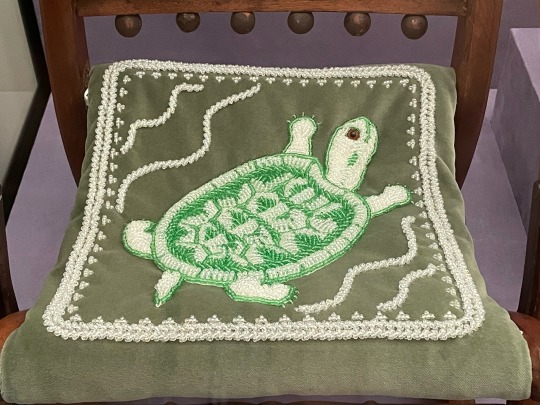

“Sky Woman (she/her)” by Karen Ann Hoffman (Oneida)
Wood, velvet, glass beads, Czechoslovakian crystals, cotton thread, sterling silver beads
“Adopted from the artist and living with the Field Museum in 2018”
from the Field Museum’s Native Truths: Our Stories, Our Voices exhibition
#native american art#first nations art#indigenous art#contemporary art#2010s#oneida#Karen Ann Hoffmann#turtle#Sky Woman#Field Museum#Native Truths: Our Stories Our Voices#exhibition#museum visit#turtle tuesday#animals in art
95 notes
·
View notes
Text









Some photos from the Miller Art Museum:
A description of/artist’s statement about (Ha)Kirinąk (To Return Home), Henry Payer’s solo exhibition.
And Back (Henry Payer, 2023 // Mixed media with windowpane)
Neutral Ground (Henry Payer, 2024 // Collage and mixed media on canvas
Devil’s Tower, WY (Henry Payer, part of the #wanderingwinnebago series, digital photography)
Description of the #wanderingwinnebago series
Rez Dog: Hounded (Camille “Katahtu’ntha” Billie, 2024 // Water based ink on Rives BFK)
May (Camille “Katahtu’ntha” Billie, 2023 // Water based ink on Rives BFK)
Riverbend (Camille “Katahtu’ntha” Billie, 2023 // Water based ink on acid free paper)
Rez Dog: Wary (Camille “Katahtu’ntha” Billie, 2024 // Water based ink on Rives BFK)
(August 16 // Sturgeon Bay, WI)
#photography#art#native american art#indigenous art#first nations art#henry payer#camille billie#miller art museum#door county#wisconsin#sturgeon bay#jessie lynn mcmains#my photos#i am so so happy i got to see both henry payer’s exhibition and the exhibition of other ndn artists#i just. am having so many feelings about it.
4 notes
·
View notes
Text





Emma Watson attends the Costume Institute Gala Benefit to celebrate the opening of the "American Woman: Fashioning a National Identity" exhibition at The Metropolitan Museum of Art on May 3, 2010 in New York City.
#emma watson#red carpet#met gala#2010#fashion#off the shoulder#white dress#Met Costume Institute Benefit Gala#beauty#british celebrities#new york
175 notes
·
View notes
Text

Charles Ethan Porter (1847-1923)
"Untitled (Cracked Watermelon)" (c. 1890)
Oil on canvas
Located in the Metropolitan Museum of Art, New York City, New York, United States
Porter was among the first African American artists to exhibit his work nationally and the only one to specialize in still lifes. The painting's subject—originally an African gourd brought to the New World by seventeenth-century Spaniards and cultivated by colonists—is significant. Porter chose to paint a watermelon, an earlier symbol of American abundance—and during the Civil War period one particularly associated with free Blacks—when it was increasingly defined by virulent stereotyping. By reclaiming the subject in artistic terms, Porter challenged a contemporary racist trope.
#paintings#art#artwork#still life painting#watermelon#charles ethan porter#oil on canvas#fine art#the metropolitan museum of art#the met#museum#art gallery#american artist#african amerian artist#black artists#history#art analysis#freedom#fruit#fruits#food#1890s#late 1800s#late 19th century
957 notes
·
View notes
Text

Lee Conklin, (Artist), American, born 1941
Procol Harum
Lithograph
1969
Procul Harum, Santana concert poster.
Exhibitions: The National Museum of Modern Art, Kyoto, Japan. "The Modern American Poster." October 21-December 4, 1983. Traveled to The National Museum of Modern Art, Tokyo, Japan, December 14, 1983-January 22, 1984
106 notes
·
View notes
Text
you really have to be fucking stupid to believe the nonsense about "Israel is waiting til big events to do big attacks"
First of all: they are committing massive murder constantly every day. Not even just since October but for decades.
Second: none of the big events people claim match up are things that actually hide that? You're just making stupid excuses to cover for countries that don't care anyway. About whole populations that have never cared about Palestinian suffering and Israeli crimes.
But most especially it's galling to see people try to claim the fucking met gala as a "big event" that would drown out war. The fucking local fundraising event that doesn't even get live TV or streaming coverage.
Because it's run by the Vogue fashion magazine by and for the fashion community in general, and to fund the Metropolitan Museum Of Arts' ongoing upkeep of fashion and clothing material exhibits in general, and to provide primary funding for the latest yearly fashion exhibition it immediately precedes.
It's something the vast majority of New Yorkers, let alone the vast majority of Americans, let alone the vast majority of the world doesn't care about. When you declare the stupid event as necessary to hide yet another daily Israeli crime, you're basically revealing you don't actually think of the reality of the ongoing genocide, or have any touch with your own national reality.
But hey the same people saying this shit didn't start pretending to care until 6 months ago. Could never be me, my rabbi grandfather taught us that what Israel was already doing was evil and we should support our Palestinian brothers and sisters and oppose further restrictions and encroachment on their land, lives, and existence. So I already was aware of this shit, of how zionism is at best harmful by accident and most of the time harmful on purpose by like 1999.
Just, when I see people convinced that their favorite little internet day must be a smokescreen for an attack it's like. How are you this unserious as a person? What went wrong with your perception of world events that you have to qanon your way into believing niche events are being used as cover? It's frankly treating real life genocide like it's part of a fucking ARG.
96 notes
·
View notes
Note
Hello! rly appreciating your posts, in particular the ones about GLAM... it made me curious if you or your followers happen to have any resources/literature to recommend on 2 areas of interest?:
1. Relating salvage anthropology to modern day ideas of trauma porn
2. Palestinian-led museums/archives/oral history projects/other collections or exhibitions of note. (Or if not literature, any names involved besides the few I know of like POHA/the nakba archive/the arab resource center for popular arts; the palestine museum; librarians & archivists with Palestine; activestills; forever our land; and art for gaza)
Anyway, again, thanks for all the time/work you’re putting into analysis and info dissemination <3
hello, thanks for sending this in. sooo i have like. no idea about the first one haha but i have so many for the second one.
The Institute for Palestine Studies has a bunch of scholarly articles and anaylsis about Palestine
Librarians and Archivists for Palestine is not completely Palestinian led but it's one that I'm a part of and really like, even though you already mention it.
The Palestine Museum Digital Archive is an AMAZING resource led by Palestinians in Palestine. I recommend scrolling through their intifada posters, downloading them, printing them, and hanging them around town.
The Palestinian Oral History Archive project in case people were wondering what POHA is.
The Museum of the Palestinian People in DC is really great and has a lot of digitized features.
The Palestine Museum US has a lot of books as well, based on Turtle Island.
The Arab American National Museum is not Palestinian led but I can vouch that they're a great group.
The Met has a lot of Palestinian clothing BUT.... warning in that it is very colonial in its arrangement and description and we dont super know how people got the material they have. If you want to look at the content feel free, though. Will say that Wafa Ghnaim, one of the leading experts on Tatreez in Turtle Island is working on recataloguing the Palestinian collection.
Visualizing Palestine is an infographic organization that might interest you.
The Nakba Archive for people wanting to check it out.
The Library of Congress is. Honestly it's pretty racist but it does have content if you wanna look at it.
Tirazain is a tatreez pattern library that's really cool.
There might be more that I'm forgetting but here are some just from me sitting here thinking for the past few minutes. If anyone else has any recommendations, feel free to add.
226 notes
·
View notes
Text

David Hammons, African-American Flag, 1990
"David Hammons (American, b. 1943)} re-creates the familiar pattern of the American flag using the colors of the flag for the Universal Negro Improvement Association (U.N.I.A), an early twentieth-century black nationalist organization The U.N.I.A. flag featured broad bands of red, black, and green as symbolic colors intended to unite all people of African origin under one banner. Hammons's new version conflates the two flags, perhaps implying that a black nation resides within the United States or, conversely, that such a distinction is impossible. Hammons created African-American Flag for Black USA, a 1990 exhibition at the Museum Overholland in Amsterdam, which was the first exhibition of African American art to be organized by a European museum." (MCA)
#David Hammons#art#flag#African American#flag design#vexillology#culture#politics#Africa#America#USA
70 notes
·
View notes
Text







The first major solo museum presentation of fourth-generation Navajo weaver Melissa Cody (b. 1983, No Water Mesa, Arizona) spans the last decade of her practice, showcasing over 30 weavings and a major new work produced for the exhibition. Using long-established weaving techniques and incorporating new digital technologies, Cody assembles and reimagines popular patterns into sophisticated geometric overlays, incorporating atypical dyes and fibers. Her tapestries carry forward the methods of Navajo Germantown weaving, which developed out of the wool and blankets that were made in Germantown, Pennsylvania and supplied by the US government to the Navajo people during the forced expulsion from their territories in the mid-1800s. During this period, the rationed blankets were taken apart and the yarn was used to make new textiles, a practice of reclamation which became the source of the movement. While acknowledging this history and working on a traditional Navajo loom, Cody’s masterful works exercise experimental palettes and patterns that animate through reinvention, reframing traditions as cycles of evolution.
Melissa Cody is a Navajo/Diné textile artist and enrolled member of the Navajo/Diné nation. Cody grew up on a Navajo Reservation in Leupp, Arizona and received a Bachelor’s degree in Studio Arts and Museum Studies from Institute of American Indian Arts, Santa Fe. Her work has been featured in The Barnes Foundation, Philadelphia (2022); Crystal Bridges Museum of American Art, Bentonville, AR (2021); National Gallery of Canada, Ottawa (2019–2020); Museum of Northern Arizona, Flagstaff (2019); SITE Santa Fe (2018–19); Ingham Chapman Gallery, University of New Mexico, Albuquerque (2018); Navajo Nation Museum, Window Rock (2018); and the Museum of Contemporary Native Arts, Institute of American Indian Arts, Santa Fe (2017–18). Cody’s works are in the collections of the Stark Museum of Art, Orange, Texas; the Minneapolis Institute of Arts; and The Autry National Center, Los Angeles. In 2020, she earned the Brandford/Elliott Award for Excellence in Fiber Art.
Melissa Cody: Webbed Skies currently on exhibition at MoMA PS1 through September 9nth, 2024
IDs Under the cut
Top to Bottom, Left to Right:
White Out. 2012. 3-ply aniline dyed wool. 17 × 24″ (43.2 × 61 cm)
Deep Brain Stimulation. 2011. Wool warp, weft, selvedge cords, and aniline dyes. 40 x 30 3/4 in. (101.6 x 78.1 cm)
World Traveler. 2014. Wool warp, weft, selvedge cords, and aniline dyes. 90 x 48 7/8 in. (228.6 x 124.1 cm)
Into the Depths, She Rappels. 2023. Wool warp, weft, selvedge cords, and aniline dyes. 87 x 51 9/16 in. (221 x 131 cm)
Lightning Storm. 2012. 3-ply aniline dyed wool. 14 × 20″ (35.6 × 50.8 cm)
Pocketful of Rainbows. 2019. Wool warp, weft, selvedge cords, and aniline dyes. 19 x 10 3/4 in. (48.3 x 27.3 cm)
Path of the Snake. 2013. 3-ply aniline dyed wool. 36 × 24″ (91.4 × 61 cm)
70 notes
·
View notes
Text

US Returns $80 Million-Worth of Stolen Artifacts to Italy
It looked more like a museum exhibition of Italian art than a crime scene, but in the Central Institute for Restoration’s offices, located inside a former women’s prison in central Rome, some 600 works of art were put on display Tuesday morning.
Ranging from life-sized bronze statues to tiny Roman coins, from oil paintings to mosaic flooring, the pieces span the 9th century BC to the 2nd century AD and amount to just one year’s stolen and trafficked art confiscated by Manhattan prosecutor Col. Matthew Bogdanos’ team and returned to Italy.
The trafficked works, pillaged from the Italian regions of Lazio, Campania, Puglia, Calabria and Sicily, were sequestered in New York and New Jersey last year.
The returned works, together with 60 items repatriated last year, are worth more than $80 million (or roughly €73.6 million) — but are just a drop in the bucket when it comes to artwork still hidden away in private warehouses and on display in museums in the United States, Bogdanos said on the sidelines of a presentation to the media on Tuesday.


Bogdanos said the $80 million of items does not include a further 100 items his team has just seized in the US.
What makes the seizure and return of stolen artifacts so difficult is that authorities often have no idea what they are looking for, according to Gen. D. Francesco Gargaro, commander of the Carabinieri for the Protection of Cultural Heritage.
“When artifacts are taken from clandestine graves, they have never been cataloged,” he said. That means that, in addition to the items themselves, their historical context was stolen, robbing archaeologists of valuable information. (Instead, investigators work backwards, assessing paperwork and provenance claims for artifacts provided by their owners, as well as undertaking technical tests to best confirm a piece’s true origins.)
Most of the recent items returned to Italy were dug out of clandestine excavations or stolen from churches, museums and private individuals, Gargaro said.
Among the items on display on Tuesday was a cuirass and two bronze heads dating back to the 4th-3rd century BC that were confiscated from a gallery owner in New York.
There was also an Umbrian bronze statue depicting a warrior stolen from an Italian museum in 1962 that was found in a well-known American museum.




And a mosaic floor depicting the myth of Orpheus enchanting wild animals with the sound of the lyre from the mid-3rd to mid-4th century AD was recovered after being stolen from a clandestine excavation in Sicily in the early 1990s. It was confiscated from the private collection of a well-known New York collector.
Italy’s Carabinieri Cultural Heritage Protection unit uses artificial intelligence to search for stolen cultural assets under a new program called “Stolen Works Of Art Detection System” (SWOADS), which searches for taken items by scanning the web and social media for images.



“The return to Italy of cultural assets of such importance, both for their numerical consistency and for their historical-artistic value, is another significant achievement, Italy’s culture ministry undersecretary Gianmarco Mazzi said Tuesday.
“In addition to being works of art of inestimable value, they represent the high expression of our history, our culture and our national identity.”
In 2023 alone, 105,474 pieces of art worth more than €264 million (or $287 million) were found and confiscated worldwide thanks to the artificial intelligence project, according to Gargaro.
By Barbie Latza Nadeau.
#US Returns $80 Million-Worth of Stolen Artifacts to Italy#stolen art#looted art#trafficked art#ancient artifacts#archeology#archeolgst#history#history news#ancient history#ancient culture#ancient civilizations#ancient rome#roman history#roman empire#roman art#ancient art
63 notes
·
View notes
Text


We mourn the loss and celebrate the life of Faith Ringgold (1930-2024). A painter, mixed media sculptor, performance artist, activist, writer, teacher and lecturer, Ringgold’s impact on American art cannot be understated, and her legacy is especially felt in New York City. Born in Harlem, Ringgold attended City College for both her B.S. and M.A. degrees in visual art before travelling the world, which would inform the rich narratives in her work and the development of her iconic story quilts. She revolutionized notions of craft in fine art with her unique style of narrative quilt paintings while centering African American and feminist voices. The distinguished artist received more than 80 awards and 23 Honorary Doctorates throughout her prolific career. Ringgold’s work has been exhibited internationally and belongs in the collections of numerous institutions including the Brooklyn Museum, the Metropolitan Museum of Art, the High Museum of Art, the Studio Museum in Harlem, and the National Gallery of Art in Washington, D.C.
Ringgold’s mosaic artwork “Flying Home: Harlem Heroes and Heroines (Downtown and Uptown)” (1996) at 125 St (2,3) station honors Harlem notables and makes them fly. Ringgold has said of the work: "I love every one of these people. I wanted to share those memories, to give the community - and others just passing through - a glimpse of all the wonderful people who were part of Harlem. I wanted them to realize what Harlem has produced and inspired." Faith Ringgold herself is certainly a Harlem heroine who has inspired and will inspire many for years to come.
📸1: MTA A&D/Cheryl Hageman, 2: Trent Reeves
83 notes
·
View notes
Text
#WorldSparrowDay:
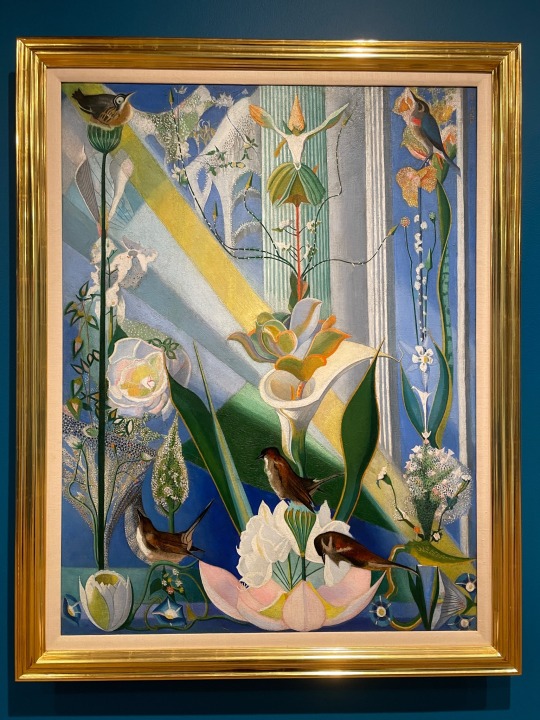
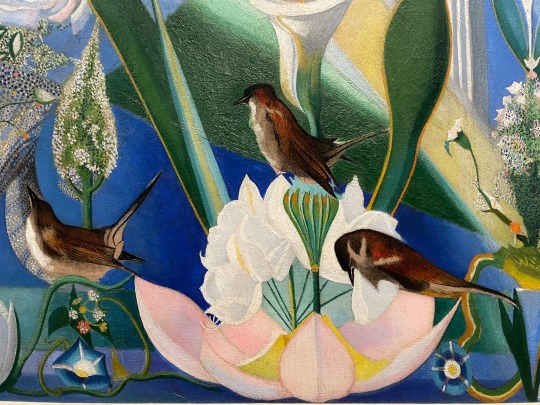

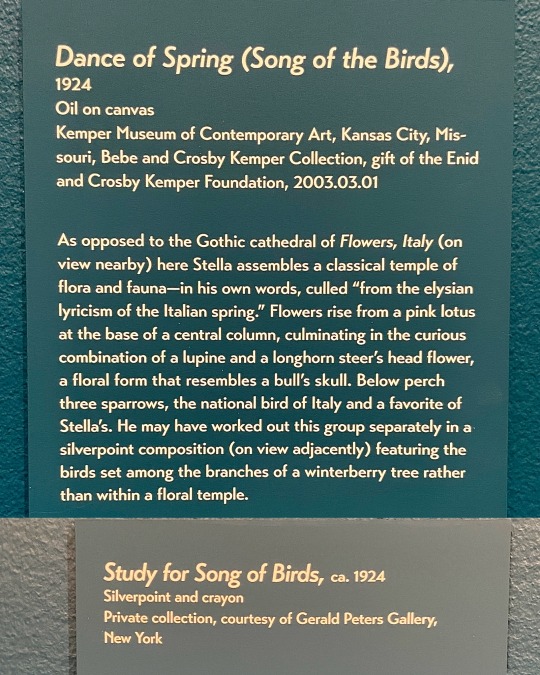
Joseph Stella (Italian-American, 1877-1946)
1. Dance of Spring (Song of the Birds), 1924, oil on canvas
2. Study for Song of Birds, c.1924, silverpoint & crayon
from the 2023 “Joseph Stella: Visionary Nature” exhibition at Brandywine Museum of Art
“Stella assembles a classical temple of flora and fauna - in his own words, culled ‘from the elysian lyricism of the Italian spring.’ Flowers rise from a pink lotus at the base of a central column, culminating in the curious combination of a lupine and a longhorn steer's head flower, a floral form that resembles a bull's skull. Below perch three sparrows, the national bird of Italy* and a favorite of Stella's. He may have worked out this group separately in a silverpoint composition (on view adjacently) featuring the birds set among the branches of a winterberry tree rather than within a floral temple.”
🆔 Italian sparrow (Passer italiae)
#animals in art#animal holiday#20th century art#museum visit#birds in art#bird#birds#sparrow#Italian sparrow#national bird#national animal#animal emblem#World Sparrow Day#trio#painting#oil painting#drawing#Joseph Stella#1920s#exhibition#Brandywine Museum of Art#American art#modern art
14 notes
·
View notes
Text
Indigenous people welcome return of 16th-17th century cloak to Brazil

The return of a Tupinambá cloak made from red guará bird feathers to Brazil, after more than three centuries in storage in Denmark, was a reason for celebration among the indigenous people in southern Bahia. The Danish National Museum donated the artifact to the National Museum in Rio de Janeiro.
The Brazilian museum confirmed the cloak's arrival on July 11 and announced plans to exhibit the piece in the coming weeks.
However, ten other similar cloaks, also made from guará feathers, remain in European museums, according to a survey by American researcher Amy Buono from Chapman University in California, USA.
According to the research, there are four more cloaks in the National Museum of Denmark, in addition to the one that was returned to Brazil. The Natural History Museum of the University of Florence, Italy, holds two others. Additionally, Tupinambá cloaks can be found in the Museum of Cultures in Basel, Switzerland; the Royal Museum of Art and History in Brussels, Belgium; the Quai Branly Museum in Paris, France; and the Ambrosian Library in Milan, Italy.
Continue reading.
#brazil#brazilian politics#politics#indigenous rights#denmark#museums#image description in alt#mod nise da silveira
47 notes
·
View notes
Text
SET SIXTEEN - ROUND ONE - MATCH THREE


"Memorial to a Marriage" (2002 - Patricia Cronin) / “The Island” (2009 - Walton Ford)
MEMORIAL TO A MARRIAGE: This is a very skilled piece, and there are all these little details, like the blanket over the couple, and the way their feet touch. And it's the artist and her (now) wife - made in a time when they couldn't marry. As a lesbian I can acknowledge that marriage is not the 'end all, be all' of gay rights, but this makes me feel a lot of things and I could stare at it for hours. (@beelzeblogging)
THE ISLAND: I first saw this in a museum when I was 12 and it completely wrecked my brain. Art about extinction has a major pull to me and this is probably the genesis of that. At the time as a pre-teen I was both horrified and allured by this work and its violence and vulgarity, but also the delicate beauty inherent to the thylacine. There's a sort of latticework to all of the spindly interlacing limbs and tails. I think this is a piece of art that wears its meaning on its sleeve but it communicates the horror and tragedy of human-driven extinction in such a potent and wordless way that it doesn't feel heavy handed to me. This topic makes me feel guilt and despair, the intensity of wish makes me feel like I'm being crushed within machinery, and this is sort of an organic crushing machine, which I think exemplifies that feeling. I think about this painting all of the time and I love it very much. (@catboyclarity)
("Memorial to a Marriage" is a mortuary sculpture made of carrera marble measuring 27 x 42 x 84 inches (69 x 107 x 213 cm) and weights three tons. It is located Woodlawn Cemetery, Brooklyn. Artist Patricia Cronin modeled the sculpture after herself and her wife Deborah Kass before same sex marriage was legal in the United States. It has been exhibited in over 50 locations and there are bronze versions in permanent collections of various museums, including the National Portrait Gallery.
"The Island" is a watercolour triptych by Walton Ford. Panel 1 measures 95 ½ in. x 36 in. (242.6 cm x 91.4 cm), panel 2: 95 ½ in. x 60 in. (242.6 cm x 152.4 cm), and panel 3: 95 ½ in. x 36 in. (242.6 cm x 91.4 cm). It is held by the Crystal Bridges Museum of American Art.)
143 notes
·
View notes
Text
.

Today, Jan. 30 California celebrates Fred Korematsu Day of Civil Liberties and the Constitution. Where does Fred Korematsu come in? Mr. Korematsu was an American civil rights activist who stood up to the U.S. government’s wrongful incarceration of over 120,000 people of Japanese ancestry living on the West Coast during World War II. Even without support from his family or community, he disobeyed the government’s orders, and as a result, spent over two years in various prisons and wartime incarceration sites. His case went to the Supreme Court, and in 1944, the Court ruled against him, claiming the mass incarceration was a “military necessity.” Nearly 40 years later, the government finally issued apologies and reparations to the camp survivors who remained, and in 1998 President Bill Clinton awarded Mr. Korematsu the Presidential Medal of Freedom, the highest civilian award in the United States.
In the same year (1998), California also launched the California Civil Liberties Public Education Program. The program, managed by the California State Library, funds projects that educate the public about civil liberties injustices carried out based on an individual or group’s race, national origin, immigration status, religion, gender, or sexual orientation (including, but not limited to, the internment of Japanese Americans during World War II). Over 400 projects have been funded since the program’s birth, including video and audio broadcasts, books, graphic novels, photo collections and exhibits, museum displays, arts performances, material preservation, educational guides, websites, public art and monuments, and more. To learn more about the program, visit library.ca.gov/grants/civil-liberties.
67 notes
·
View notes
Text
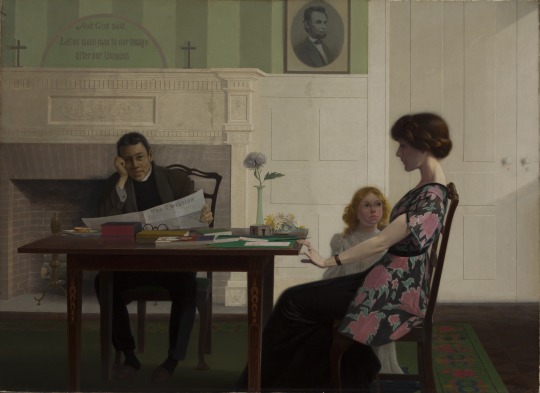
Harry Willson Watrous - The Drop Sinister—What Shall We Do with It? (ca. 1913)
Around 1913, Watrous painted The Drop Sinister, What Shall We Do with It?, which was visually similar to his other works at the time, but, by addressing an issue of social and moral concern, was unique among his paintings. It is said to be the first known portrait of an American interracial family. The father wears a clerical collar and holds a Christian newspaper in his hand; on the wall is a portrait of Abraham Lincoln and a quotation, "And God said, Let us make man in our own image after our likeness."
The painting caused a stir when it was exhibited at the National Academy of Design and at the Century Club in New York. "Harry W. Watrous preaches and paints well an interesting sermon on the negro question in The Drop Sinister," commented American Art News, which also called it "one of his best canvases." This "study in the fruits of miscegenation…caused an extraordinary amount of discussion, residents of one typically Southern city threatening to wreck the art museum if it was shown there."
The painting appears to depict a mixed marriage, which was illegal in many states at the time. The Crisis, the N.A.A.C.P. journal edited by W.E.B. DuBois, had a different idea about what was going on in the picture:
The people in this picture are all "colored"; that is to say the ancestors of all of them two or three generations ago numbered among them full-blooded Negroes. These "colored" folk married and brought to the world a little golden-haired child; today they pause for a moment and sit aghast when they think of this child's future.
What is she? A Negro? No, she is "white." But is she white? The United States Census says she is a "Negro." What earthly difference does it make what she is, so long as she grows up a good, true, capable woman? But her chances for doing this are small! Why?
Because 90,000,000 of her neighbors, good Christian, noble, civilized people are going to insult her, seek to ruin her and slam the door of opportunity in her face the moment they discover "The Drop Sinister." (source)
167 notes
·
View notes